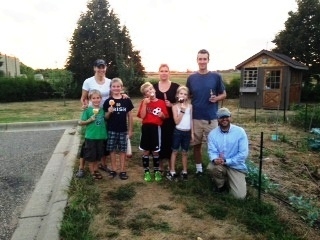Master Gardener Tricia was in the garden with 5 wonderful kids and one mom volunteer. They harvested 23 pounds of veggies! Grape tomatoes, summer squash, beans, eggplant, zucchini, beets, kale pok chio and maybe a couple other things.
Pok Choy vs. Bok Choy
Pok Choy, or Bok Choy as it is commonly known to non Guyanese, has been cultivated in China for over 6,000 years. After Spain conquered the Phillipines in the 16th century, large numbers of Chinese immigrated to the islands and brought bok choy with them. Bok choy made its way to Europe in the 18th or 19th century.
Today more than 20 varieties of bok choy exist in Asia. Varieties are now grown in the United States and Canada. The most common varieties found in the United States are bok choy and baby bok choy, a smaller, more tender version. Bok choy is available year-round in supermarkets throughout North America
Pok Choy is one of those vegetables that you don’t want to over cook, or over do (less is more with seasoning). It is best enjoyed in a simple flavorful dish, where you can truly taste the crunchiness of the leaves and deliciousness of the pok choy. The recipe below, is quick and simple and highlights the flavors of the pok choy.
Ingredients4 baby pok choy (about 1 pound), split horizontally
4 teaspoons reduced-sodium soy sauce
2 teaspoons lime juice
1 teaspoon lime zest
1/4 teaspoon sugar
1 teaspoon sesame oil
DirectionsPlace the pok choy in a steamer basket and place the basket over (not in) simmering water. Steam until the base of the pok choy is just tender when pierced with the tip of a knife, about 6 minutes.
Whisk together the soy sauce, lime juice, lime zest and sugar in a small bowl. Transfer the pok choy to a platter and drizzle with the soy mixture. Drizzle with the sesame oil and serve.
Thanks Jr. Master Gardening Group!
- Contributing Writer – Joni Fletty

 The tomatoes are ripening like crazy now, and we enjoyed finding so many varieties of color, shape and size! Those heirloom tomatoes the Junior Master Gardeners planted from seed back in April are now taller and wider than the kids! We did observe and wonder about the funny lines and cracks on some of the tomatoes we picked.
The tomatoes are ripening like crazy now, and we enjoyed finding so many varieties of color, shape and size! Those heirloom tomatoes the Junior Master Gardeners planted from seed back in April are now taller and wider than the kids! We did observe and wonder about the funny lines and cracks on some of the tomatoes we picked. 




































